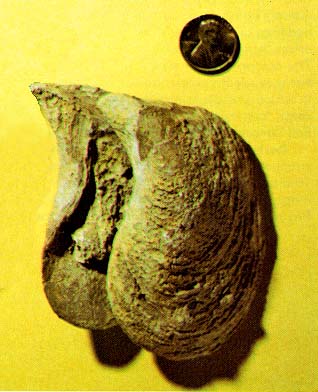



Ancient Life in Kansas Rocks, part 18 of 27
Orthomyalina, the clam in the photo below, is interesting in a number of respects. As can be seen from the interior of the right valve, the area about the pointed beak lacks the teeth or interlocking features that are common in most clams. This clam and others like it were held together by a ligament and muscle. The ligament area is that portion along the top of the shell (dorsal margin) bearing parallel striations or grooves. Orthomyalina is easily recognized by its relatively heavy, coarse shell and rectangular outline. It is commonly found in vast numbers crowded together in limestones or calcareous shales. It lived in relatively quiet shallow water, most probably attached to the bottom by numerous threadlike strands (byssal threads) that extended from between the shells in the curved area along the front (anterior) margin like in its modern relatives, the mussel. (Haskell Limestone, Upper Pennsylvanian)

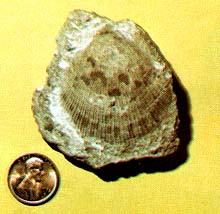
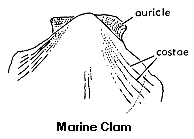
Aviculopecten, the marine clam shown above, is one of the clams that is very nearly equilateral and is thus difficult to distinguish from the brachiopods. Only a trace of an auricle, or ear-like lobe (see drawing) can be seen at the upper right margin of the specimen in the photograph.
The radiating ribs, or costae, are a typical feature of the group to which it belongs. The well known Shell Oil emblem is derived from the living scallop, which is a close relative of this clam. Some of these clams attached themselves to the bottom by means of byssal threads, but others were free moving and swam about by means of clapping the valves together, rapidly expelling water and moving in a jet-propelled darting fashion. (Kansas City Group, Upper Pennsylvanian)
Wilkingia is a clam, common and widespread in rocks of the Upper Paleozoic. Figured is a typical elongate specimen with concentric ridges. (Florena Shale, Permian)
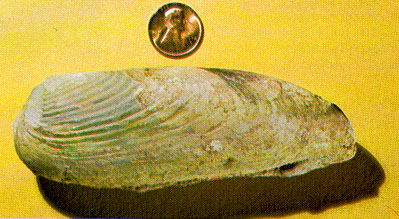
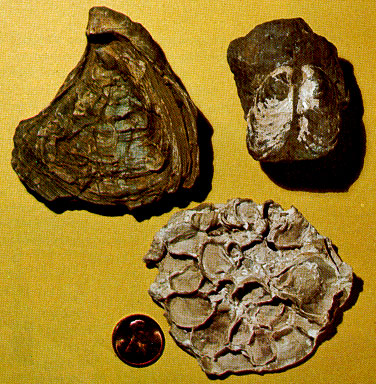
Gryphaea in the upper left is a rather large oyster ranging in size to over four inches long. The right valve is seen nestling within the left valve rather like a lid. The shells of oysters do not interlock with hinge teeth but remain together through the action of muscles, and lack the bilateral symmetry of the clams. Oysters attach themselves by the left (largest) valve to some object: another shell, a rock, the roots of trees such as mangroves, and to pilings and piers. They like on shallow marine or brackish water. Gryphaea is found in Cretaceous rocks in western Kansas but not in Paleozoic rocks.
Pseudoperna in the lower right is another oyster. Very small, it lived in congested groups. In western Kansas Cretaceous rocks, they commonly appear as slab-like incrustations on the shell of a very large species of the clam Inoceramus. The specimens here are on such as fragment. (Niobrara Formation, Upper Cretaceous)
All species of Inoceramus are not so large, as the specimen in the upper right reveals. This clam, concentrically wrinkled, also comes from western Kansas and is a characteristic Cretaceous fossil. Each valve, although lacking hinge teeth, is nearly a mirror image of the other and is thus distinguishable from the oyster. (Pierre Shale, Upper Cretaceous)
Kansas Geological Survey
Placed online Feb. 1997
URL = "http://www.kgs.ku.edu/Publications/ancient/f18_clams.html"
Send comments and/or suggestions to webadmin@kgs.ku.edu